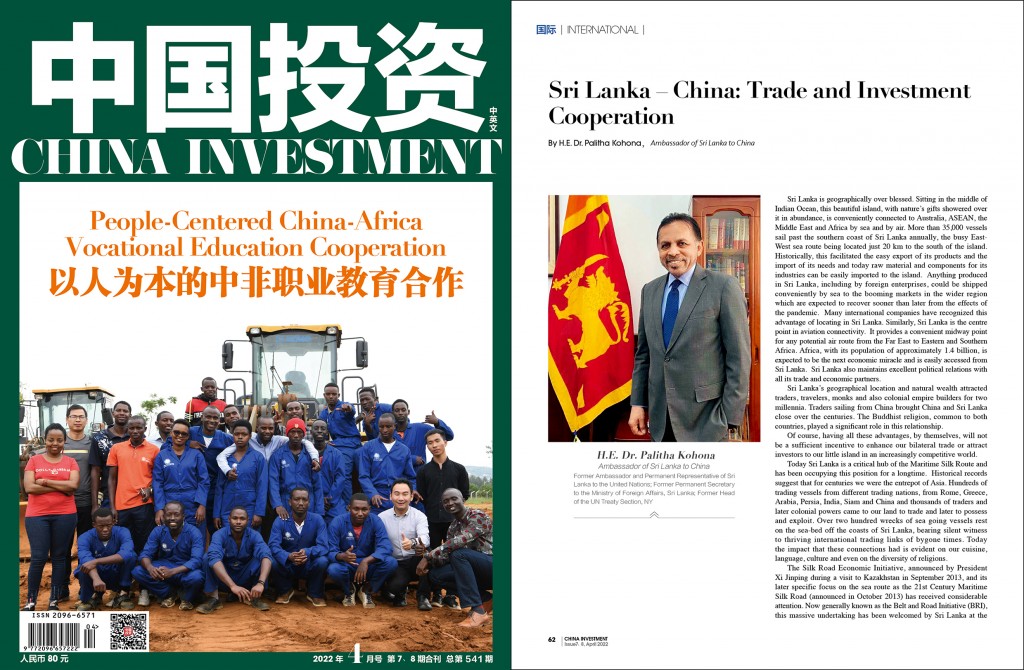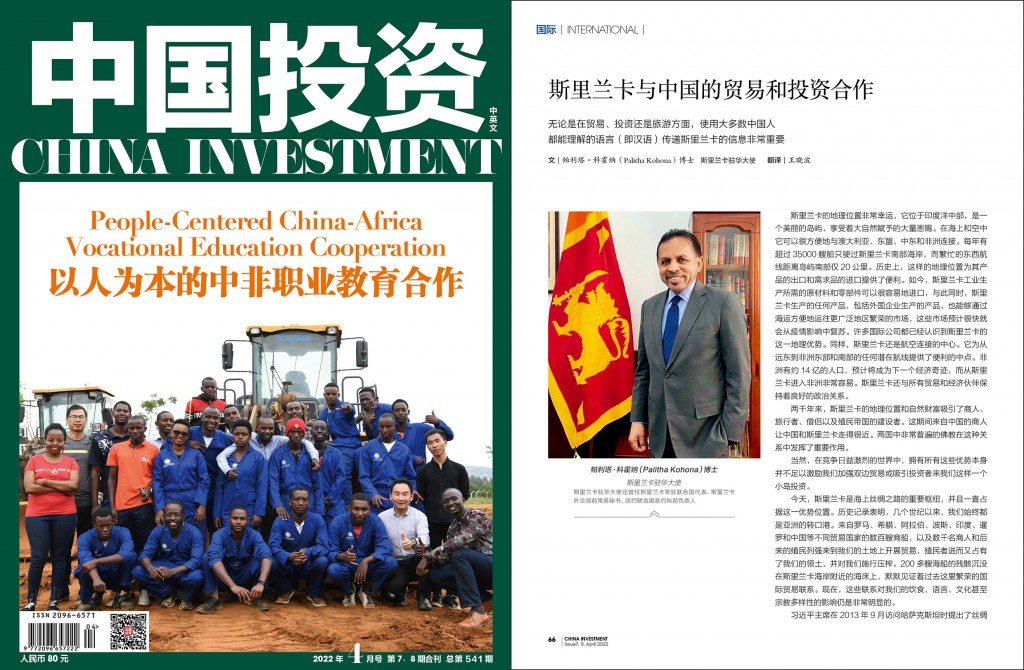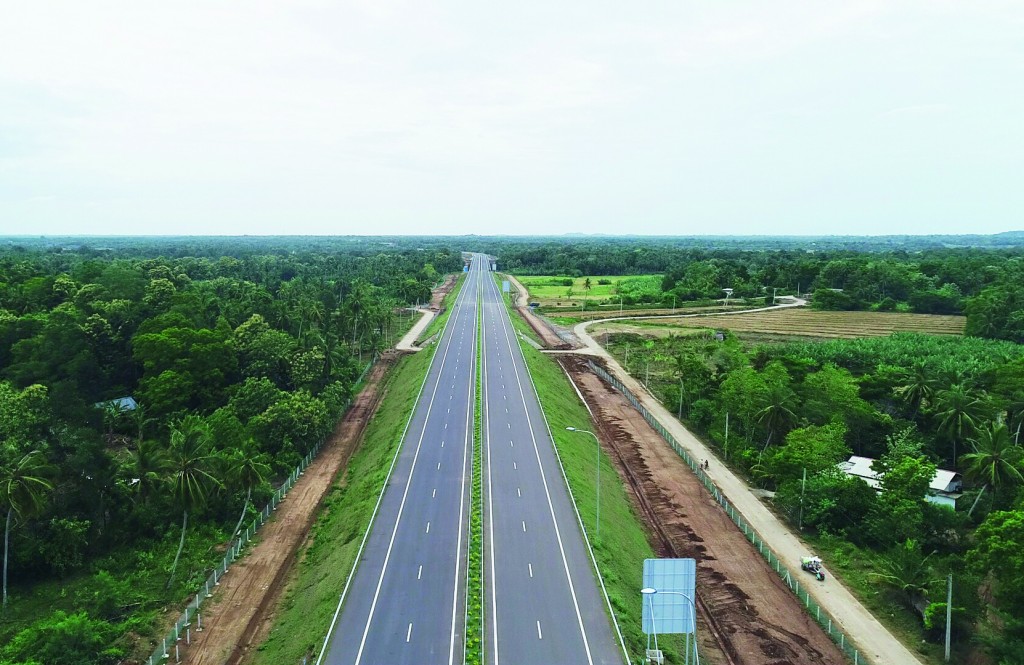By H.E. Dr. Palitha Kohona, Ambassador of Sri Lanka to China
文|帕利塔·科霍纳(Palitha Kohona)博士 斯里兰卡驻华大使 翻译|王晓波
导读
Sri Lanka is geographically over blessed. Sitting in the middle of Indian Ocean, this beautiful island, with nature’s gifts showered over it in abundance, is conveniently connected to Australia, ASEAN, the Middle East and Africa by sea and by air. More than 35,000 vessels sail past the southern coast of Sri Lanka annually, the busy East-West sea route being located just 20 km to the south of the island. Historically, this facilitated the easy export of its products and the import of its needs and today raw material and components for its industries can be easily imported to the island. Anything produced in Sri Lanka, including by foreign enterprises, could be shipped conveniently by sea to the booming markets in the wider region which are expected to recover sooner than later from the effects of the pandemic. Many international companies have recognized this advantage of locating in Sri Lanka. Similarly, Sri Lanka is the centre point in aviation connectivity. It provides a convenient midway point for any potential air route from the Far East to Eastern and Southern Africa. Africa, with its population of approximately 1.4 billion, is expected to be the next economic miracle and is easily accessed from Sri Lanka. Sri Lanka also maintains excellent political relations with all its trade and economic partners.
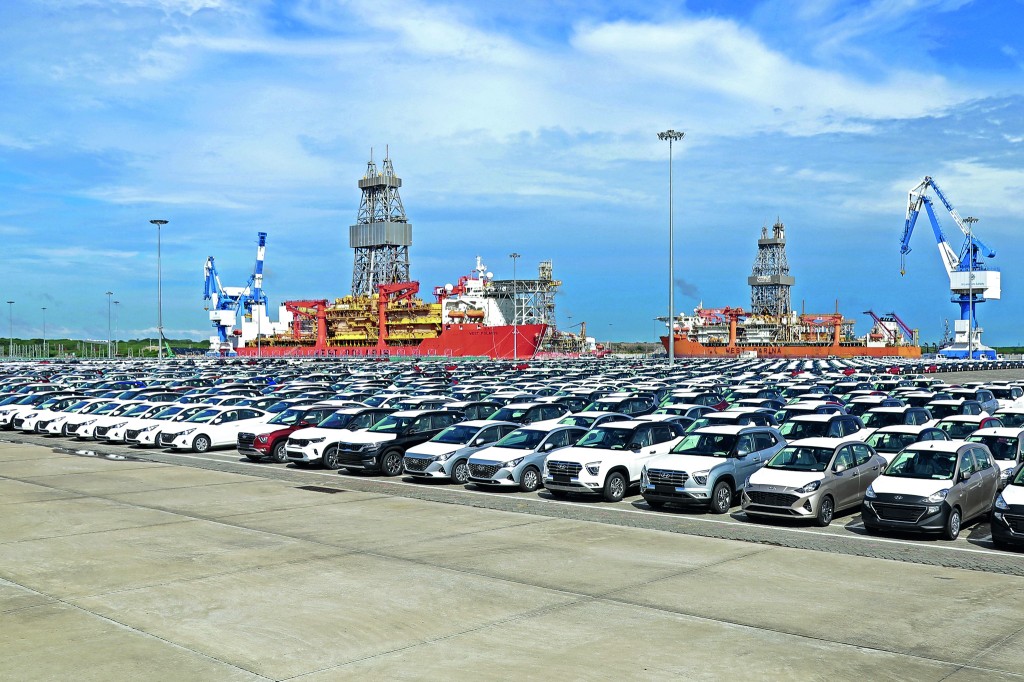
⬆ On Dec.14,2021,Hambantota Port,a key project under “BRI”, jointly built by China and Sir Lanka, located at the southern end of Sri Lanka. It is a comprehensive artificial deep-water port. ( from Xinhua News Agency, provided by the media office of the prime minister’s office of Sri Lanka )
Sri Lanka’s geographical location and natural wealth attracted traders, travelers, monks and also colonial empire builders for two millennia. Traders sailing from China brought China and Sri Lanka close over the centuries. The Buddhist religion, common to both countries, played a significant role in this relationship.
Of course, having all these advantages, by themselves, will not be a sufficient incentive to enhance our bilateral trade or attract investors to our little island in an increasingly competitive world.
Today Sri Lanka is a critical hub of the Maritime Silk Route and has been occupying this position for a longtime. Historical records suggest that for centuries we were the entrepot of Asia. Hundreds of trading vessels from different trading nations, from Rome, Greece, Arabia, Persia, India, Siam and China and thousands of traders and later colonial powers came to our land to trade and later to possess and exploit. Over two hundred wrecks of sea going vessels rest on the sea-bed off the coasts of Sri Lanka, bearing silent witness to thriving international trading links of bygone times. Today the impact that these connections had is evident on our cuisine, language, culture and even on the diversity of religions.
The Silk Road Economic Initiative, announced by President Xi Jinping during a visit to Kazakhstan in September 2013, and its later specific focus on the sea route as the 21st Century Maritime Silk Road (announced in October 2013) has received considerable attention. Now generally known as the Belt and Road Initiative (BRI), this massive undertaking has been welcomed by Sri Lanka at the highest levels. it is likely to be the major factor in regional economic relations. The BRI, if properly managed, could bring considerable economic benefits to Sri Lanka. Already, commentaries describe the Belt and Road Initiative as one of the largest infrastructure and investment projects in history, covering more than 71 countries, including 60% of the world’s population and 33% of the global gross domestic product as of 2019. With over 200 cooperation agreements already signed with 145 participant countries and 32 international organisations, it is intended to make 4 – 8 trillion USD available for investment in the wider region. China has invested billions of dollars in the South Asian group of countries including Pakistan, Nepal, Bangladesh and Afghanistan to improve their basic infrastructure, with wide implications for China’s global trade regime. This project can also create new economic corridors linking China’s massive economy to other regions. Already, investments made by China have had a seminal impact on the economies of many countries, especially in Africa. The World Bank has commented that the spurt in the growth rate of certain African economies was caused primarily by China’s investments in infrastructure.
It is significant that the IMF has elevated the Yuan to the status of a reserve currency, although it still occupies only a small segment of global transactions. The RMB denominated Cross Border Interbank Payments System (Cips) is gaining in popularity, particularly with the conflict in Europe heightening tensions and the weaponising of the SWIFT, and is likely to play an increasingly prominent role in global financial transactions.
Sri Lanka has benefitted significantly from the Chinese investments in the development of the Colombo Port City and the Hambanthota Harbour. Once these flagship projects are fully functional, the financial and other benefits to the country would be extensive.
Of course, there are criticisms of the BRI and many of these carry little or no real justification. They emanate mainly from sources that have been used to dominating and exploiting developing countries for the past three to four hundred years. We have heard of the debt trap and Chinese strategic aspirations accompanying the BRI with little effort at substantiation. Glib and well rehearsed propaganda often takes the place of reason and logic. Unfortunately, behind all this there appears to be a reluctance to accept the rise of Asia, particularly China. Many have suggested that this is the reality of our times that has to be accepted – hopefully in good grace.
Sri Lanka’s advantages must be marketed effectively to the Chinese business community, and potential investors, remembering that the Chinese business landscape is dominated by SOEs.
China is a huge market for consumer items which Sri Lanka must exploit as it seeks to recover from the devastation caused by the Covid 19 pandemic. China has the biggest middle income population in the world, over 400 million people with excess spending capacity. The GDP of China reached Yuan 114.37 trillion in 2021 reflecting a growth rate of 8.1%. In 2022, the growth rate will settle down to an estimated 5.5%, still way ahead of most of the developed world. Many, especially European manufacturers, recognize China as the most lucrative market place in the world, especially for luxury goods. A casual walk through any shopping mall bears this out without a trace of doubt. China also holds international reserves exceeding 3 trillion USD. Against this economic background and in the context of the close bilateral relationship between our two countries, this should be an invitation to the Sri Lanka business community to intensify its efforts to access the Chinese market across the spectrum, both in search of investment partners and expanded trading links. The recently concluded Regional Comprehensive Economic Partnership (RCEP) has further widened the market place of which China is the core. China’s trade with the other RCEP members is estimated at USD 10.96 trillion. Officially, it is the world’s largest trading bloc by economic size – representing 30.5% of the world’s GDP, (The GDP of the RCEP is estimated at USD 25.9 trillion) according to a recent report of the UN Conference on Trade and Development (UNCTAD). There will be flow through benefits for Sri Lanka by being associated with the Chinese market, especially through the conclusion of a free trade agreement.
Due to the way Sri Lanka’s economy had been managed over the years, there is still a continuing emphasis on growing and exporting black tea. Other important export items include, exceptional gemstones, coconut products, high end garments and apparel, and such products. There is considerable room for expanding the range of products being exported to China. Widespread interest in Sri Lanka’s Ceylon Hong Cha, black tea, is evident in all sectors of Chinese society. Chinese live streamers have been promoting Ceylon Black Tea energetically. Hardly any Chinese visitor to Sri Lanka has returned home without acquiring a stack of tea packets. Exports of Sri Lankan tea to China tea have grown by over 10% every year since 2010, and now amount to approximately 15,000 tons valued at USD 76 million, although most of it comes in bulk form. It has been suggested that this increase could be doubled in light of the obvious consumer interest in our tea.
Sri Lanka must look at the big picture and enhance its efforts to expand its exports across the board to China, and of course to the world, as other countries of the region such as Pakistan and Singapore have done so successfully. Enormous market opportunities are there for the taking. A recent initiative saw the introduction of Sri Lankan handicrafts, especially its silver ware, to the Chinese market through the government owned Laksala, a business specializing in Sri Lankan handicrafts. Sri Lanka’s current economic crisis may also be addressed through a concerted effort to encourage more and a wider range of exports. Constant reference has been made to the range of luscious fruits and fisheries products available in Sri Lanka. The size and the sweet taste of the Sri Lankan crabs have been commented on by many gourmets. Again one hears of the fond memories articulated by visitors of these items so abundantly available in Sri Lanka.
The Chinese side also needs to take further measures to accommodate our export aspirations and desire to secure wider access to this lucrative market. Sri Lankan exporters still feel that they are required to circumvent too many barriers, some of which are too difficult for small scale exporters to comprehend. The one restaurant in Shanghai which imports Sri Lankan crabs is constantly overbooked. We require sympathetic understanding of the Chinese authorities if we are to obtain wider access to the Chinese market and also make progress with our own efforts to eliminate absolute poverty.
China is also the biggest source of foreign direct investments (FDI) in the world as well as the magnet for FDI itself. Sri Lanka is encouraging inward investments to fast track its economy. In 2021, China’s global FDI outflow exceeded USD 145 billion. China has invested over 145 billion dollars in the United States over the years. It has also invested almost Euro 120 billion over the last 20 years in the European Union, and its investments in Australia, peaked at A$ 15.4 billion in 2016. It has committed USD 60 billion to Pakistan and over USD 20 billion to Bangladesh. Sri Lanka’s Colombo Port City (CPC) and the Hambantota Port and industrial zone (HIP) were financed by China. Once fully operational, the CPC is expected to become the glittering financial hub in the Indian Ocean between Singapore and Dubai. In the recent months, we have received substantial commitments of investments from Chinese companies in the CPC and the HIP, including a ground breaking investment of over USD 490 million in the proposed financial centre. Negotiations are continuing on the marina that will embellish the CPC. Sri Lanka is encouraging investors from around the world to benefit from the exceptional opportunity presented by the CPC. Other major corporations have expressed interest in investing in the HIP, including in steel making and cement manufacture. Chinese investments in ventures in Sri Lanka could help to open up other opportunities for exports, as companies mulling relocating outside China could consider the advantages of the HIP and CPC and the lucrative markets to which Sri Lanka has ready access.
169 million Chinese travelled abroad in 2019. But, in Sri Lanka, we received only 167,000 of them. This is also another aspect of the economic relationship on which Sri Lanka is focusing. With exceptional natural beauty, a history that spans 2500 years, an astounding range of wildlife for a small island and massive archeological sites second to none and a warm welcoming people, Sri Lanka has been named as a top island tourist destination. In 2019, the Lonely Planet publication named it as the number-one travel destination for the year.
Among the many Chinese who visited Sri Lanka in the past, the most prominent was the travelling monk, Fa Xian, in 410 AD. His memoires were left in the “A Record of Buddhistic Kingdoms, Being an Account by the Chinese Monk Fa-Xian”. He spent two years at the Abhayagiri monastery in Anuradhapura. 13 missions had been sent to China by the Kings of Anuradhapura between 131 AD and 989 AD. In 428 AD, King Mahanama sent a model of the Sacred Tooth Relic Shrine to the Chinese Emperor. Marco Polo, who travelled extensively in Asia as the emissary of the Great Kublai Khan, visited the island twice (in 1284 AD and again in 1293 AD) seeking to obtain from the Sinhala king the Tooth Relic and the alms bowl of the Buddha which were the treasured possessions of the king. He had also observed that Sri Lanka was the “best island of its size in the world”. In the early 1405, Admiral Zheng He visited the island and returned on five more occasions. He left an inscribed stone pillar in Galle.
Sri Lanka needs 40,000 beds for our hotel industry. If, as planned, one million Chinese could be encouraged to travel to Sri Lanka, there would be enough opportunities to invest in more hotels, resorts and hospitality related ventures. Tourism is expected to be a major income generator for the country. In 2019, the contribution of travel and tourism to the GDP (% of GDP) was 12.6 %. Tourists will also be the pioneers in introducing Sri Lankan products to the Chinese market, including the already popular black tea, coconut products, garments and spices. The tourist industry has been a magnet for investment in many other countries. Over 404,000 were directly employed in this sector before the pandemic.
Accessing the Chinese market or approaching it as a new comer will require skills and strategies which are different to those employed in the past when accessing the traditional Western markets.
It is important to convey Sri Lanka’s messages, whether on trade, investments or tourism, in the language that the majority of Chinese understand, i.e. Chinese. Relying on English alone is insufficient and ineffective as the vast majority of Chinese tend not to use English. Although English is taught in schools, very few seem to be familiar with it.
We need to understand the mindset of the Chinese and their cultural attitudes. Too often traders launch themselves in to the Chinese market place without understanding the mindset and cultural attitudes of the people of this ancient and vast country with its well established and rich culture. China has a history and a culture that spans many millennia. Its culture has been conditioned by its own unique circumstances which require patience and care to appreciate. In common with the other parts of East Asia, the Chinese also tend to do business generally with those whom they know and trust. It also requires effort to develop confidence and trust with ones potential business partners.
There are many commonalities between the dominant culture of Sri Lanka and the culture of China. For example, the respect for elders. Both cultures have been heavily influenced by Buddhism. But there are clear distinctions too. The Chinese work ethic, discipline and their sense of beauty are exemplary and much could be learned from them.
Dealing with East Asia also requires considerable patience. As the adage goes, “It is necessary to plant a tree and pluck the fruit when ripe rather than rush to pick fruit on existing trees”.
Sri Lanka is an easy place to do business and locate an office or an industry. It is an easy place to live with good education facilities for children and a mild climate and welcoming environment. It hardly ever gets very cold except perhaps in the highest of mountains and never really gets unbearably hot. The country remains lush and green throughout the year and almost everything grows with little effort. As a former colonial administrator wrote in his handing over notes to his successor, “One should avoid leaning too long on ones walking stick as it might sprout roots. This land is so delightfully fertile”. The colonials were quick to cover the mist wrapped mountain slopes with coffee and then luscious tea and the lower and dryer slopes with rubber. Today, many other crops are grown commercially, including the once abandoned coffee, flowers, avocado, mangoes, bananas, vegetables, etc.
Our bilateral political relationship has been strengthened considerably in recent times. Sri Lanka which has clearly embraced a non aligned foreign policy, has developed a close and warm relationship with China. The leaders have established a high degree of mutual trust and confidence. It is now the time to convert this political comforts level to mutually advantageous trade and investment benefits. China has been generous and forthcoming in supplying us with vaccines when the Covid 19 pandemic was threatening to spin out of control. Almost 26 million doses of Sinopharm vaccine were shipped to Sri Lanka including a 3 million dose gift. The pandemic is substantially under control with the airports now being opened to vaccinated visitors. Consequently, tourist numbers are steadily creeping up. China has also extended a helping hand to Sri Lanka at a time when the country began to face its worst financial crisis in recent times. All the signs indicate that Sri Lanka will recover sooner than later. In the circumstances, it is for Sri Lanka to further consolidate the reassuring foundation for attracting significant Chinese investments to Sri Lanka.
斯里兰卡的地理位置非常幸运,它位于印度洋中部,是一个美丽的岛屿,享受着大自然赋予的大量恩赐。在海上和空中它可以很方便地与澳大利亚、东盟、中东和非洲连接。每年有超过35000艘船只驶过斯里兰卡南部海岸,而繁忙的东西航线距离岛屿南部仅20公里。历史上,这样的地理位置为其产品的出口和需求品的进口提供了便利。如今,斯里兰卡工业生产所需的原材料和零部件可以很容易地进口,与此同时,斯里兰卡生产的任何产品,包括外国企业生产的产品,也能够通过海运方便地运往更广泛地区繁荣的市场,这些市场预计很快就会从疫情影响中复苏。许多国际公司都已经认识到斯里兰卡的这一地理优势。同样,斯里兰卡还是航空连接的中心。它为从远东到非洲东部和南部的任何潜在航线提供了便利的中点。非洲有约14亿的人口,预计将成为下一个经济奇迹,而从斯里兰卡进入非洲非常容易。斯里兰卡还与所有贸易和经济伙伴保持着良好的政治关系。
两千年来,斯里兰卡的地理位置和自然财富吸引了商人、旅行者、僧侣以及殖民帝国的建设者。这期间来自中国的商人让中国和斯里兰卡走得很近。两国中非常普遍的佛教在这种关系中发挥了重要作用。
当然,在竞争日益激烈的世界中,拥有所有这些优势本身并不足以激励我们加强双边贸易或吸引投资者来我们这样一个小岛投资。
今天,斯里兰卡是海上丝绸之路的重要枢纽,并且一直占据这一优势位置。历史记录表明,几个世纪以来,我们始终都是亚洲的转口港。来自罗马、希腊、阿拉伯、波斯、印度、暹罗和中国等不同贸易国家的数百艘商船,以及数千名商人和后来的殖民列强来到我们的土地上开展贸易,殖民者进而又占有了我们的领土,并对我们施行压榨。200多艘海船的残骸沉没在斯里兰卡海岸附近的海床上,默默见证着过去这里繁荣的国际贸易联系。现在,这些联系对我们的饮食、语言、文化甚至宗教多样性的影响仍是非常明显的。
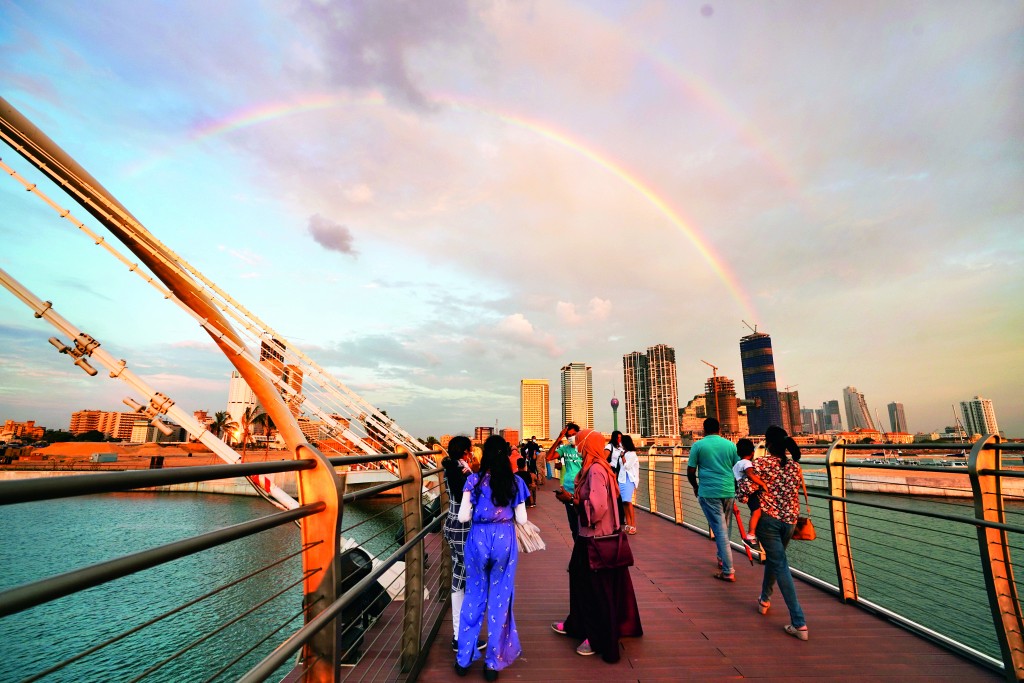
⬆ 2022年 1月10日,人们在斯里兰卡科伦坡港口城游艇码头区的步行桥上观赏风景。在海滨步行大道上,为庆祝中斯建交65周年而举办的“中斯友好合作图片展”同时展出(新华社记者 唐璐摄))
习近平主席在2013年9月访问哈萨克斯坦时提出了丝绸之路经济倡议,以及后来重点聚焦海上路线的二十一世纪海上丝绸之路(2013年10月宣布)受到了极大的关注。现在众所周知的“一带一路”倡议(BRI)这一宏伟的项目得到了斯里兰卡最高级别领导人的欢迎,因为它可能是区域经济关系中的重要因素。如果管理得当,它将为斯里兰卡带来非常可观的经济效益。现在已经有评论说,“一带一路”倡议是历史上最大的基础设施和投资项目之一,它覆盖了多达71个国家,包括了世界上60%的人口,占到截至2019年全球国内生产总值的33%。已经有145个参与国和32个国际组织签署了200多个合作协议,计划在更广泛的地区提供4-8万亿美元的投资。中国已经向包括巴基斯坦、尼泊尔、孟加拉国和阿富汗在内的南亚国家投资了数十亿美元,助力其改善基础设施,这对中国的全球贸易体系有着广泛的影响。该倡议还可以创造新的经济走廊,将中国庞大的经济与其他地区连接起来。中国的投资已经对许多国家的经济产生了意义深远的影响,尤其是在非洲。世界银行评论说,某些非洲经济体增长率的激增主要得益于中国对其基础设施的投资。
重要的是,国际货币基金组织已经将人民币提升到储备货币的地位,尽管它在全球交易中仍然只占一小部分。同时以人民币计价的跨境银行间支付系统(CIPS)越来越受欢迎,尤其是随着欧洲冲突加剧以及SWIFT的武器化,跨境银行间支付系统可能在全球金融交易中发挥越来越突出的作用。
斯里兰卡从中国对科伦坡港口城和汉班托塔港的开发投资中受益匪浅。一旦这些旗舰项目能充分发挥作用,斯里兰卡将获得广泛的财政和其他利益。
当然,对“一带一路”倡议也有批评,但许多批评几乎没有或根本没有真正的理由。它们主要来自过去三四百年间一直用于统治和剥削发展中国家的宣传渠道。我们听到了伴随着“一带一路”倡议而来的债务陷阱和中国的战略抱负的说法,可是并没有看到什么证据。巧舌如簧、精心炮制的宣传取代了理性和逻辑。不幸的是,这一切的背后是不愿接受亚洲的崛起,尤其是中国的崛起。许多人认为,这是我们这个时代必须被接受的现实——希望能被善意地接受。
斯里兰卡必须有效地向中国的企业界和潜在投资者介绍自身的优势,并且清楚中国的企业格局是由国有企业主导的。
中国是一个巨大的消费品市场,斯里兰卡在寻求从新冠疫情造成的损失中恢复时,必须充分利用这个市场。中国是世界上中等收入人口最多的国家,超过4亿人的消费能力过剩。中国的GDP在2021达到114.37万亿元,实现了8.1%的增长率。2022年,增长率预计将稳定在5.5%,仍然远远领先于大多数发达国家。许多人,特别是欧洲的制造商,都认为中国是世界上最赚钱的市场,尤其对于奢侈品来说。在中国的任何一家购物中心随便走走就可以毫无疑问地证明这一点。此外,中国还拥有超过3万亿美元的国际储备。在这样的经济环境中和我们两国之间密切的双边关系背景下,斯里兰卡的商界应当加紧努力,从各个领域进入中国市场,包括寻找投资伙伴和扩大贸易联系。最近刚刚开始执行的区域全面经济伙伴关系(RCEP)进一步拓宽了以中国为核心的市场范围。中国与其他RCEP成员国的贸易额估计将达到10.96万亿美元。根据联合国贸易和发展会议(UNCTAD)最近公布的一份报告,从官方角度看,RCEP是世界上经济规模最大的贸易集团,占世界GDP的30.5%(RCEP国家的GDP总值估计为25.9万亿美元)。通过与中国市场建立联系,特别是通过缔结自由贸易协定,斯里兰卡将获得源源不断的利益。
由于斯里兰卡多年来采取的经济管理方式,人们始终强调以种植和出口红茶为主。其他重要的出口产品包括特殊宝石、椰子制品、高端服装等产品。因此,扩大出口到中国的产品范围仍然具有很大的空间。中国社会的各个阶层显然都对斯里兰卡的锡兰红茶拥有很大的兴趣。中国的直播带货一直在大力推广锡兰红茶。几乎所有到斯里兰卡旅游的中国游客在回家时都会购买一大堆茶包。自2010年以来,斯里兰卡对中国茶叶的出口每年都以超过10%的速度增长,目前已达到约15000吨,价值7600万美元,尽管它们大部分是散装的。有人认为,考虑到中国消费者对我们的茶叶有明显的兴趣,出口增幅可能会翻一倍。
斯里兰卡必须放大格局,加强努力,全面扩大对中国的出口,当然也要扩大对世界的出口,就像该地区的其他国家,比如巴基斯坦和新加坡,成功做到的那样。中国有巨大的市场机会可供斯里兰卡开发利用。拉克萨拉是一家专门从事斯里兰卡手工艺品的斯里兰卡国有企业。最近的一项倡议是通过拉克萨拉将斯里兰卡的手工艺品,尤其是银器引入中国市场。通过协调一致的努力,鼓励更多更广泛的出口,斯里兰卡目前的经济危机也可能得以解决。人们经常提到斯里兰卡能够提供的各种美味水果和渔业产品,斯里兰卡螃蟹的大小和甜味已经被众多的美食家评论过,人们经常可以听到游客对斯里兰卡这些丰盛美食表达的美好回忆。
中国方面也需要采取进一步措施,支持我们的出口愿望和更广泛地进入这个利润丰厚的市场的渴慕。斯里兰卡的出口商仍然认为,他们需要避开太多的障碍,其中一些障碍对小规模出口商来说很难接受。上海一家进口斯里兰卡螃蟹的餐厅经常需要超额预定。斯里兰卡希望更广泛地进入中国市场,并在消除绝对贫困的努力中取得进展,因此我们需要得到中国的更多同情和理解。
中国是世界上最大的外国直接投资来源国,同时自身也深深吸引了外国直接投资。斯里兰卡正在鼓励外来投资,旨在加快其经济发展。仅2021年,中国在全球的直接投资就超过了1450亿美元。而多年来,中国在美国的累计投资也超过1450亿美元。在过去20年里,中国还在欧盟投资了近1200亿欧元,在澳大利亚的投资在2016年达到154亿澳元的峰值。中国向巴基斯坦承诺投资600亿美元,向孟加拉国承诺投资200多亿美元。斯里兰卡的科伦坡港口城以及汉班托塔港口和工业区也是由中国出资兴建的。一旦进入全面运营后,科伦坡港口城预计将成为印度洋上位于新加坡和迪拜之间一个耀眼的金融中心。近几个月来,我们得到了中国公司对科伦坡港口城和汉班托塔港的大量投资承诺,包括对拟建的金融中心超过4.9亿美元的突破性投资。有关港口码头的谈判仍在继续,它会让科伦坡港口城变得更美丽。斯里兰卡鼓励世界各地的投资者从科伦坡港提供的特殊机遇中受益。其他大公司也对投资汉班托塔港表现出兴趣,包括炼钢和水泥制造。中国企业在斯里兰卡的投资有助于它们获得更多的出口机会,因为考虑在中国境外设立企业的公司可以充分利用科伦坡港口城和汉班托塔港的优势以及斯里兰卡已经准备好的利润丰厚的市场。
2019年有1.69亿的中国人出国旅游,但是前往斯里兰卡的游客只有16.7万人。旅游是斯里兰卡经济领域正在重点关注的另一个行业。斯里兰卡拥有无与伦比的自然美景、2500年的历史、令人惊叹的野生动物种类、首屈一指的大型考古遗址和热情友好的人民,因此它一直被认为是顶级的岛屿旅游目的地。2019年,《孤独星球》杂志将其列为本年度第一大旅游目的地。
在过去访问过斯里兰卡的众多中国人中,最著名的是公元410年前往斯里兰卡的游历僧侣法显。他的回忆录收录在《佛国记》中。他在阿努拉达普拉的阿卜哈亚吉里修道院待了两年。公元131年至公元989年,阿努拉达普拉国王向中国共派遣了13次使团。公元428年,马哈纳马国王向中国皇帝赠送了一座圣牙舍利神殿的模型。马可·波罗作为忽必烈大汗的使者在亚洲广泛游历,他曾两次(公元1284年和1293年)访问斯里兰卡,试图从僧伽罗王那里获得牙舍利和佛陀的施舍碗,这些都是国王珍贵的财产。他还发现,斯里兰卡是“世界上同等规模中最漂亮的岛屿”。1405年初,郑和访问了该岛,后来又五次重访。他在加勒留下了一根刻有铭文的石柱。
斯里兰卡的酒店业需要4万张床位。如果能按计划鼓励100万中国人前往斯里兰卡旅游,那就有足够的机会投资更多的酒店、度假村和与酒店相关的企业。旅游业预计将成为斯里兰卡主要收入来源。2019年,旅游业对GDP的贡献率达到了12.6%。游客还将率先向中国市场介绍斯里兰卡的产品,包括已经很受欢迎的红茶、椰子产品、服装和香料。旅游业一直吸引着许多其他国家的投资。疫情爆发前,该行业的直接就业人数超过了404000人。
斯里兰卡以新来者的身份进入中国市场时需要采用与以往进入传统西方市场时不同的方法和策略。无论是在贸易、投资还是旅游方面,使用大多数中国人都能理解的语言(即汉语)传递斯里兰卡的信息非常重要。仅仅依靠英语是不够的,也是无效的,因为绝大多数中国人不倾向于使用英语。虽然中国的学校里教英语,但似乎能够使用它的人数还非常少。
我们还需要了解中国人的思维方式和他们的文化态度。很多时候,贸易商在进入中国市场时,并不了解这个古老而辽阔土地上人民的思维方式和文化理念,以及这个国家悠久而丰富的文化。中国有着跨越数千年的历史和文化。它的文化一直受到自身独特环境的影响,需要耐心、细心地去理解。与东亚其他地区一样,中国人一般也倾向于和自己认识和信任的人做生意。因此,这就需要努力与潜在的商业伙伴建立信心和信任。
斯里兰卡的主导文化和中国文化之间有着许多共同点,例如,对长者的尊重。两国文化都深受佛教的影响。不过,双方文化间也存在明显的区别。中国人的职业道德、纪律和审美能力都堪称楷模,可以从中学习的东西有很多。
与东亚打交道也需要相当大的耐心。正如谚语所说,“要先种树,然后在成熟时摘下果实,而不是匆忙在现有的树上采摘果实”。
斯里兰卡是一个很容易做生意、设立办公室或经营企业的地方。它也是一个宜居之地,有良好的儿童教育设施,气候温和,环境舒适。除非是在最高的山上,否则它的天气不会很冷,同时它也永远不会酷暑难耐。斯里兰卡一年四季郁郁葱葱,几乎所有的东西都能不费吹灰之力地生长。正如一位前殖民行政长官在给他的继任者提供的笔记中所写,“人应该避免长时间倚靠手杖,因为它可能会发芽。这片土地非常肥沃”。那些殖民者很快就在薄雾笼罩的山坡上种植了咖啡和甘美的茶叶,同时又在较低和较干燥的山坡上种上了橡胶。如今,许多其他作物也得到商业化种植,包括曾经被遗弃的咖啡、鲜花、鳄梨、芒果、香蕉、蔬菜等。
近年来,我们两国的双边政治关系得到大大加强。斯里兰卡明确奉行不结盟的外交政策,与中国发展了密切而友好的关系。两国领导人之间也高度互信。现在是将这种政治友好关系转变为互惠贸易和投资利益的时候了。在新冠肺炎肆虐并有可能失控的时候,中国一直慷慨并且乐于为我们提供疫苗。近2600万剂国药集团的疫苗被运往斯里兰卡,其中包括300万剂的赠品。现在随着机场已向接种疫苗的游客开放,斯里兰卡的疫情基本得到控制。因此,游客人数正在稳步上升。近年来,在斯里兰卡面临最严重的金融危机时,中国也向斯里兰卡伸出了援助之手。所有迹象都表明,斯里兰卡的恢复是迟早的事情。在这种情况下,斯里兰卡应该进一步巩固能够吸引大量中国投资的稳定基础。


